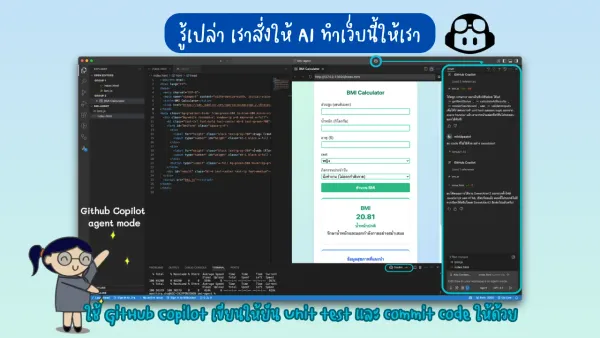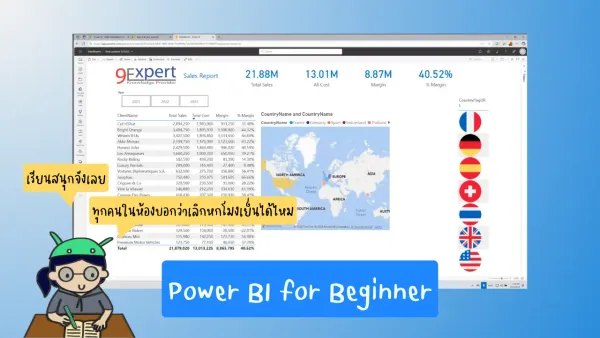มาเรียนรู้และฝึกฝน การนำเสนอผลงานเป็นภาษาอังกฤษเบื้องต้น กันเถอะ
แน่นอนว่าชีวิตของเจ้าของบล็อกนั้น ก็ขึ้นเวทีมาบ้าง แต่ในงานที่พูดอังกฤษล้วนอย่างงาน Android Bangkok Conference ก็ใช่ว่าจะมั่นใจนัก เพราะว่าปีนึงพูดอังกฤษที เลยมาเสริมความมั่นใจกันสักหน่อย
แล้วพอดีเห็นคอร์สที่ชื่อว่า "การนำเสนอผลงานเป็นภาษาอังกฤษเบื้องต้น" หรือในชื่อภาษาอังกฤษว่า "Giving Basic Presentations in English" เลยลงเรียนกันสักหน่อย ว่าจะเป็นอย่างไรบ้างนะ
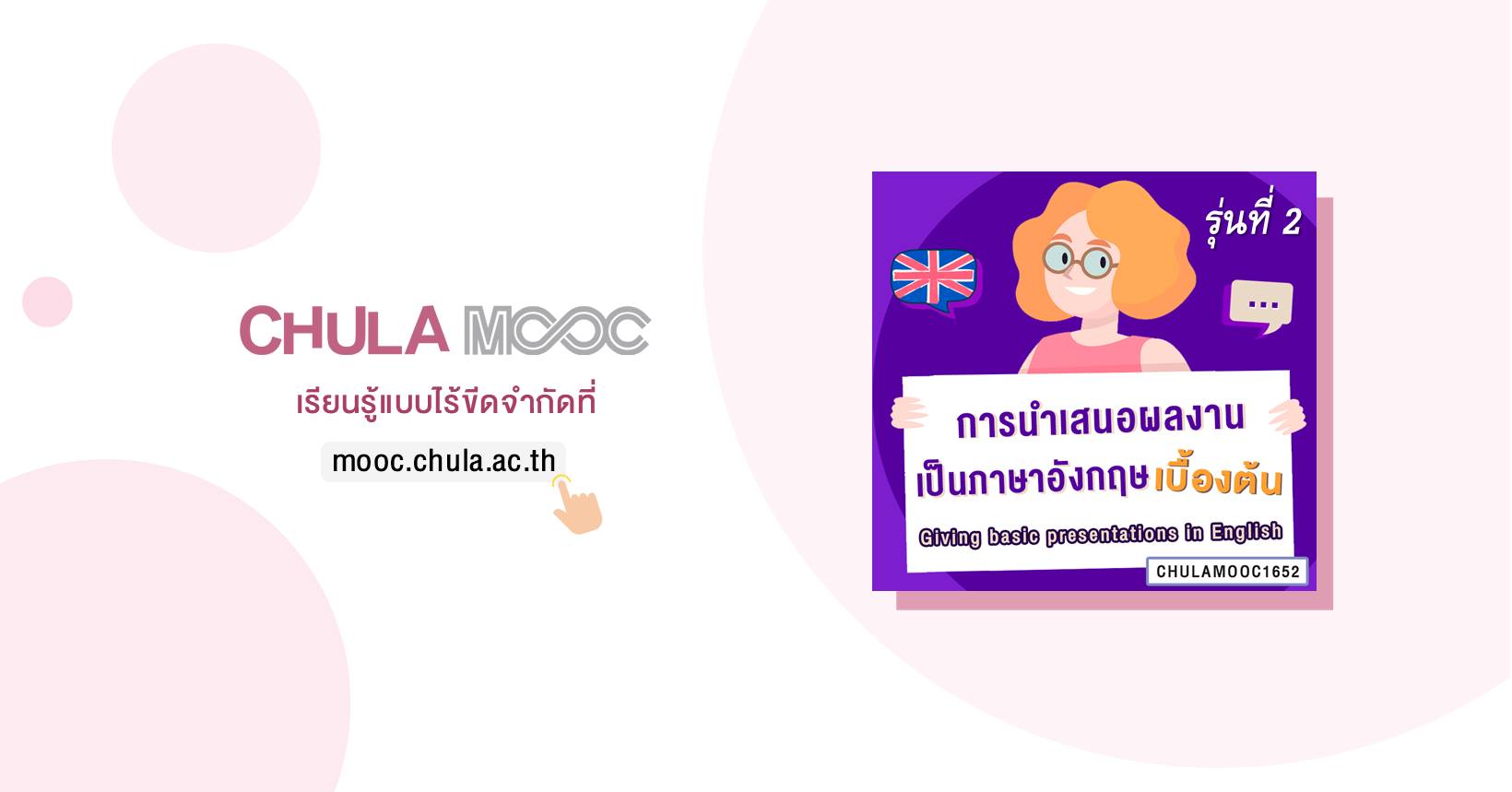
สามารถเข้าไปดูรายละเอียดแล้วเข้าเรียนได้ที่

ส่วนอันนี้ก็คือ video แนะนำคอร์ส
เนื้อหาในนี้เป็น text เยอะหน่อย ขออภัยมา ณ ตรงนี้ด้วย
Ep 1: Introduction – Presentation components
เป็นการเตรียมความพร้อม และองค์ประกอบที่ใช้ในการนำเสนอผลงานเป็นภาษาอังกฤษจ้า
1) Know the audience รู้จักลักษณะของผู้ฟัง
คนฟังมาจากสายงานเดียวกันกับเรานั้นหรือเปล่า ถ้าใช่ก็สามารถใช้คำศัพท์เฉพาะวงการนั้นๆได้
ตัวอย่างมาจากเราเอง งาน Android Bangkok Conference เป็นงานประจำปีที่ Android Developer ต้องมาฟัง และคนพูดก็เป็น Android Developer เช่นกัน ดังนั้นก็ไม่ต้องปรับอะไรมากเนอะ แต่ถ้าเป็นงานที่กว้างหน่อยอย่าง Mobile Conf ที่มีเฉพาะ Mobile Developer หรือ Code Mania ที่เป็นโปรแกรมเมอร์ทุกสาย เนื้อหาก็ต้องปรับไปตามคนฟังด้วยงี้
2) Know the venue and equipment รู้ข้อมูลสถานที่และอุปกรณ์นำเสนอ
venue คือสถานที่ และ equipment คืออุปกรณ์
ดังนั้นข้อนี้หมายความว่า เราต้องรู้ว่าเราต้องพูดที่ห้องไหน ห้องนั้นเป็นอย่างไร มีอุปกรณ์อะไรบ้าง ระบบเสียงในห้องเป็นอย่างไร เราต้องเตรียมอะไรเพิ่มไหม ส่วนใหญ่ก็ไปดูเอาวันงานนี่แหละ ก่อนที่เราจะขึ้นไปพูด บางที่ค่อนข้างน่าเศร้าใจตรงพวกอุปกรณ์นี่แหละก็ต้องทำใจกันไป
3) Know the topic and purposes รู้หัวข้อและจุดประสงค์ในการนำเสนอ
การนำเสนอผลงานเป็นภาษาอังกฤษมีทั้งหมด 4 ข้อด้วยกัน คือ
- to inform เพื่อให้ข้อมูล >> ในวิชานี้จะเน้นที่ตัวนี้นะ
- to persuade เพื่อโน้มน้าวใจ
- to entertain เพื่อให้ความบันเทิง
- to inspire เพื่อสร้างแรงบันดาลใจ
บทเรียนจะแบ่งออกเป็น 3 ก้อนใหญ่ๆ คือ
- story message เนื้อหา
- verbal message ภาษา
- visual message สื่อ
Ep 2: Story message – Make it interesting right from the start
ในส่วนของ Introduction หรือการเริ่มต้นการนำเสนอข้อมูลจะต้องมีองค์ประกอบดังนี้
1) Greeting การทักทายและแนะนำตัว
- Good morning. My name's {ชื่อตัวเอง}. I'm {ชื่อตำแหน่ง} at {ชื่อบริษัทหรือหน่วยงาน}.
- Good morning. Let me start by saying a little bit about myself.
- Welcome to {สถานที่}, I know I have met some of you, but just for a benefit of those who I have not met, My name's {ชื่อตัวเอง}.
- ถ้าเราต้องการให้เป็นทางการมากขึ้น Ladies and gentlemen, it's an honour for me to be here to address such a distinguished audience like you. My name's {ชื่อตัวเอง}.
- แนะนำที่ทำงาน I work for/represent {ชื่อบริษัทหรือหน่วยงาน}.
2) Subject หัวข้อในการนำเสนอ
- I would like to talk (to you) today about ....
- The subject / topic / focus ... of my talk / presentation / speech is about ...
3) objective / purpose วัตถุประสงค์ในการนำเสนอ
- The purpose/objective of my talk today is to update you on/ give you information about ...
- We are here today to learn to + verb
เช่น to update you on ... หรือ to give you information about ...
4) Length ความยาวในการนำเสนอ
แต่ส่วนตัวเราคิดว่าเขาน่าจะ fix เวลาพูดมาให้เราอยู่แล้วเนอะ เพราะมันก็ต้องนัดคนมาฟัง เรื่องความว่างของสถานที่ และอื่นๆอีก
- I shall only take ... minutes of your time.
- This should only last ... minutes.
5) Outline/Main Part หัวข้อหลัก และใจความสำคัญของเรื่องที่เราจะพูด
- I have divided my presentation into ... parts/sections.
- The subject can be looked at under the following headings: (First ..., Second ..., Third ...)
- We can break this area down into the following details: (First ..., Second ..., Third ...)
6) Question ให้คนฟังได้ถามเรา
เปิดโอกาสให้คนได้ถาม มี 2 แบบ คือ
1) ถามตอนจบการนำเสนอ
- I would be glad to answer any questions at the end of my talk.
2) ถามระหว่างการนำเสนอ
- If you have any questions, please feel free to interrupt.
- Please interrupt me if you have any questions.
ในส่วนนี้จะมีตัวอย่างจากอาจารย์ด้วยนะ
Ep 3: Story message – Make it well–organized in the body part
กล่าวถึงการใช้สำนวนภาษา เพื่อเรียบเรียงเนื้อหาให้ไม่ติดขัดในการนำเสนอผลงาน เรียกว่า Signpost ที่เปรียบเหมือนป้ายบอกทางว่าตอนนี้เราพูดถึงไหนแล้ว ให้ผู้ฟังเข้าใจ และตามเนื้อหาของเราได้อย่างไม่ติดขัด
ใช้ Signpost เพื่อประโยชน์ดังนี้
1) Saying what is coming เรากำลังพูดถึงเรื่องอะไร
- In this part of my presentation, I would like to tell you about + noun แปลว่า ในส่วนนี้ของ presentation ของเรา เรากำลังจะพูดถึง
- So, let me give you a brief overview. ผู้พูดกำลังให้ภาพรวมของอะไร
2) Moving on to the next point เรากำลังเปลี่ยนหัวข้อใหม่ไปที่หัวข้ออะไร
- This leads directly to the next part of my talk.
- This now leads us to the next point.
- Let’s now move on to the next point.
- Let’s now turn to the next issue.
3) Indicating the end of the section เนื้อหาในส่วนนี้กำลังจะจบลงแล้ว
- This brings me to the end of my {ลำดับที่} point.
- So much for + noun
- So, this the background of + noun/noun phrase
4) Referring back กล่าวถึงหัวข้อที่กล่าวมาแล้วในหัวข้อก่อนหน้านี้
ตัวประโยคตัวอย่างจะเกี่ยวกับ past tense นิดนึง
- As I mentioned before, …
- As I said earlier, …
- Let’s go back to where we were discussing earlier.
- Let me now come back to where I said earlier.
5) Summarizing a point กล่าวจบ หรือพูดสรุปในหัวข้อที่เราพูดถึง
- I would like to sum up the main points.
- Let me briefly summarize what I have said so far.
สำนวนสำหรับเชื่อมประโยค ใช้นำหน้าคำนาม หรือกลุ่มคำนาม
- In connection with
- Concerning/Regarding
- With respect/regard to
- According to
ตัวอย่าง
- I would like to mention some critical points in connection with concerning zero waste.
- With respect to the idea of zero waste, we need more policy.
Ep 4: Story message – Make it memorable at the end
ทำยังไงให้การจบการนำเสนอ น่าประทับใจ ประกอบด้วย
1) Signaling the end of the presentation
บอกคนฟังว่า การนำเสนอของเราจะจบลงแล้วนะ หรือให้สัญญาณกับคนฟังบอกว่ากำลังจะจบแล้ว เช่น
- Well, this brings me to the end of my presentation.
- OK, I think that’s everything I wanted to say.
- I’m now nearing the end of my talk.
- Thank you all for listening.
2) Summarizing the main points
สรุปเนื้อหาใจความสำคัญที่ได้กล่วไปแล้ว เช่น
- I’ll just run though the {จำนวน} main points.
- Before I stop, let me go through the main point again.
- To sum up then, we ... ขอกล่าวโดยสรุปว่าเรื่องที่เรากล่าวมีอะไรบ้าง
- Just to summarize the main points of my talk, {เนื้อหาใจความหลัก}
3) Recommending or suggesting something
การให้ข้อแนะนำและเสนอแนะบางอย่าง กับคนฟัง ตรงนี้จะมี หรือไม่มีก็ได้นะ เช่น
- I would suggest + sentence / noun phrase
- I therefore, recommend that we + sentence
- In my opinion, we should + verb
- What I would like to suggest is + noun phrase
4) Inviting questions
เปิดโอกาสให้คนฟังได้ถาม ประโยคเชิญชวนให้คนฟังถามคำถาม เช่น
- Now, I’ll be happy to answer any questions you may have.
- We just have time for a few questions.
- Are there any question? อันนี้เบสิคสุด
วิธีการจบการนำเสนอให้น่าสนใจ
using question จบโดยการถามคำถาม ที่เชื่อมโยงกับคำถาม
- After all, isn’t that way we are here?
- Let me just finish with a question. If we don’t do it, won’t somebody else?
quoting a well-known person การจบด้วยคำกล่าวของคนดังๆ
- As {คน} once said, {ข้อความ} เช่น As Steve Jobs once said, …
- To quote a well-known businessman, {ข้อความ}
- To put it in the word of {ชื่อคน}, {ข้อความ}
Ep 5: Verbal message – Stress in words and chunks in sentences
Verbal message คือการจัดการกับภาษาที่เราเปล่งออกไป
Word Stress การออกเสียงหนักเบาในพยางต่างๆที่อยู่ในคำ และ Chunking การแบ่งกลุ่มคำ แบ่งออกเป็น 5 หัวข้อ
1) Two-syllable words
การลงคำที่มีสองพยางค์ ปกติจะเน้นเสียงหลักที่พยางค์แรก เช่น bottle plastic paper garbage burning warming problem project
2) Multi-syllable words
การลงคำที่มีมากหรือหลายพยางค์
- การออกเสียงคำกริยาสองพยางค์ prefix + root ลงเสียงหนักที่พยางค์ที่สอง หรือ ที่รากคำ เช่น reuse (re + use) reduce unplug unwind collect explain instruct inspire
- การออกเสียงคำที่มีกลายพยางค์ -ion -sion -ment -ity -ety จะ stress ที่พยางค์หน้าพยางค์สุดท้ายก่อนหน้า เช่น pollution consumption solution emission engagement involvement community society
- คำที่เป็น adjective และ adverb เน้นเสียงที่พยางค์เดียวกัน เช่น Environmental และ Environmentally จะเน้นเสียงคำว่า men เหมือนกัน
3) number
การอ่านตัวเลข ตัวอย่างคู่คำ คือ thirteen 13 เน้นเสียง teen และ thirty 30 เน้นเสียงหน้า thir
hundred thousand billion จะเน้นเสียงหนักที่พยางค์หน้า
4) acronyms and abbreviations
การอ่านตัวย่อ โดยปกติจะเน้นพยางค์สุดท้าย เช่น A.I. (Artficial Intelligence) จะเน้นที่ I เนอะ ก่อนอื่นเราจะพูดถึงชื่อเต็มรอบนึงว่า คำย่อนี้เราจะพูดถึงอันนี้นะ เช่น A.I. refers to Artficial Intelligence.
หรืออีกคำนึงคือ W.E.D. จะเน้นเสียงที่ตัว D ตัวอย่างประโยค W.E.D. refers to World Environment Day which is on the 5th of June every year.
5) words in chunks
การแบ่งกลุ่มคำ สามารถแบ่งได้ 2 แบบ คือ
- ถ้านับเป็นปริมาณควรแบ่งเป็นกลุ่มละ 3-5 คำ จะดูกำลังดี เข้าปากผู้พูด และไม่ยาวเกินไปสำหรับคนฟัง
- แบ่งเป็น thought group คือแบ่งว่า ใคร ทำอะไร อย่างไร ที่ไหน เมื่อไหร่ เราจะเน้นหายใจเบาๆนิดนึง หลังกลุ่มคำเนอะ
ตัวอย่าง
- World Environmental Day / is the biggest annual event / for positive environmental action / and takes place on the 5th of June / every year.
- We should make changes/ in our everyday lives /to reduce heavy uses of plastic products /which includes/ plastic bottles, /plastic bags, /and plastic straws.
- Governments and communities / should come together / to explore renewable energy / as well as green technologies / and improve the quality of air pollution throughout the country.
ท้ายบทมีสรุปจ้า
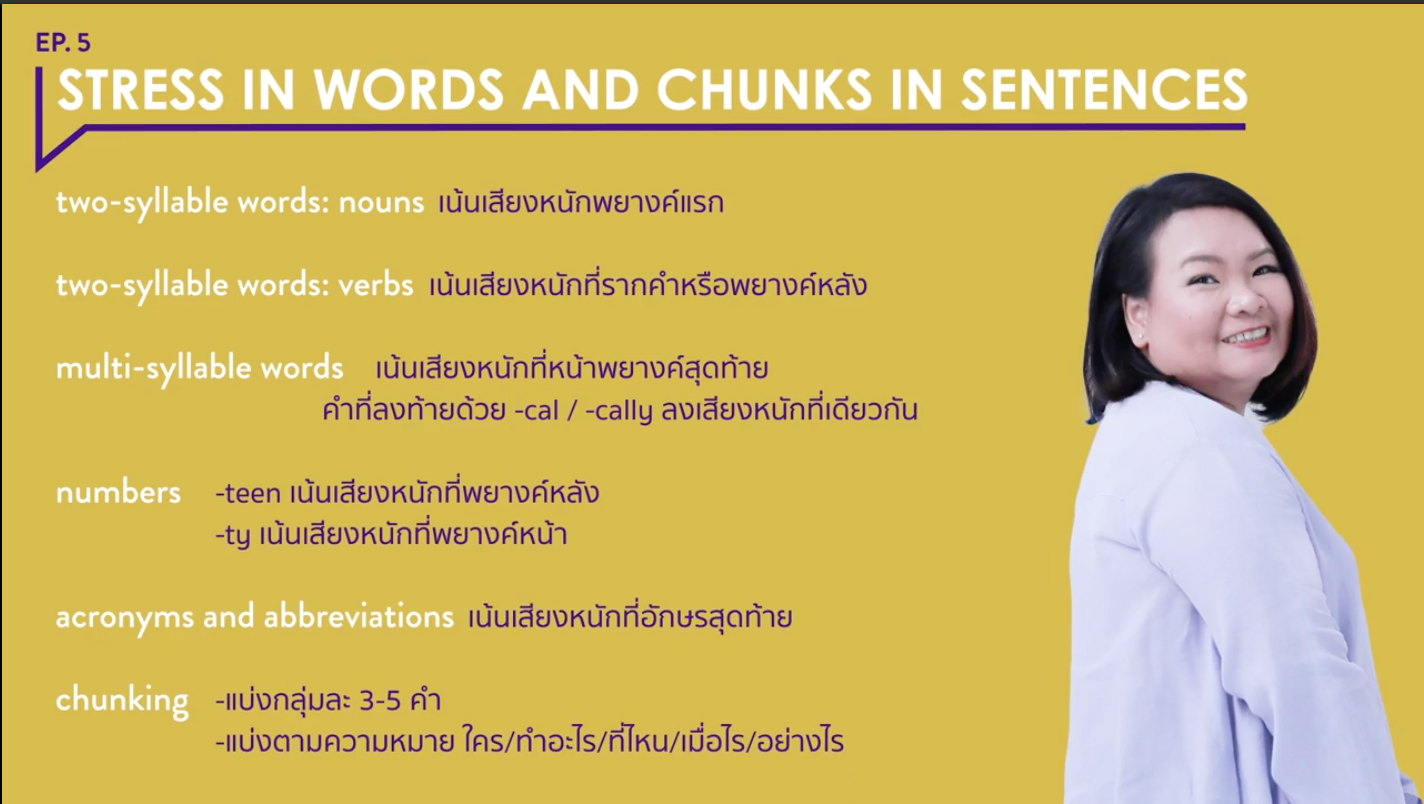
Ep 6: Verbal message – Speak with techniques
เทคนิคในการนำเสนอ มีอยู่ด้วยกัน 3 เทคนิค เพื่อทำให้ประโยคของเราสละสลวย และสื่อสารไปถึงคนฟังได้มีประสิทธิภาพมากขึ้น คือ
1) softening
ทำให้ข้อมูลนุ่มนวลขึ้น ทำได้ 2 วิธีคือ
ใช้คำที่มีความหมายบวก เช่น
- People ignored the situation เปลี่ยนจากคำว่า ignore เป็น need to be more aware of
- Some recycling bins are around the office -> We are an environmentally friendly office.
และใช้คำเล็กๆ ลดความแรงของข้อมูล ใช้คำขึ้นต้นประโยคให้ดูไม่ฟันธงในข้อมูลมากเกินไป เช่น
- It seem that ... ดูเหมือนว่า เช่น It seems that everybody uses fewer plastic cups and straws.
- Perhaps ... บางทีอาจจะเป็นอย่างนี้ เช่น Perhaps, we should upload all teaching materials next semester.
- To some extent ... ในระดับหนึ่ง เช่น To some extent, we have failed to reduce the printing.
หรือเอาคำเล็กๆไว้ท้ายประโยค เช่นใส่คำว่า a bit ตัวอย่าง We are going to reduce hard copies a bit.
2) repetition
การพูดคำนั้นซํ้าๆ โดยให้พูดซํ้าไม่เกิน 2 ครั้ง นักพูดมืออาชีพจะใช้คำซํ้าๆ เช่น more and more, better and better, greener and greener
ตัวอย่างประโยค
- It is very very important to help reduce the garbage. เราจะเน้นคำว่า very
- More and more policies have been implemented. เน้นที่คำว่า more and more
- We’d better reduce and reduce the use of disposable containers as possible.
หรือเราจะนำประโยคที่ใช้ซํ้า แยกที่กันได้ โดยมากเป็นคำสรรพนาม เช่น ขึ้นและลงด้วยคำว่า everybody ตัวอย่าง
- Everybody should be aware of the consequences, everybody.
3) tripling
คือการนำคำ 3 คำมาวางเรียงกัน เพื่อให้เกิด impact ในการนำเสนอผลงาน เป็นศิลปะในการดึงดูดความสนใจให้ผู้ฟัง อาจจะวางเรียง คำคุณศัพท์ 3 คำ คำกริยา 3 คำ คำนาม 3 คำ วลี 3 ก้อนก็ได้
คำคุณศัพท์ 3 คำ ตัวอย่างนำคำคุณศัพท์ที่มีเสียงใกล้เคียงกันมาไว้ด้วยกัน
- few, fewer and the fewest
- practical, professional and properly funded
- fast, flexible and efficient
ตัวอย่างประโยค
We should purchase reusable and refillable containers rather than disposable ones.
คำนาม 3 คำ
- คำประกาศอิสรภาพของอเมริกา life, liberty and the pursuit of happiness
- กล่าวถึง social media เช่น social media: Facebook, Twitter and Instagram
- กล่าวถึงมลภาวะ water pollution, air pollution and noise pollution
ตัวอย่างประโยค
Awareness, engagement and perpetuation is the way forward to the success in improving the quality of the environment.
คำกริยา 3 คำ
- look, listen and learn
- collect, analyze and synthesize
- reduce, reuse and recycle
ใช้คำวลี 3 วลี
- think fast, think smart and think green
- tell us the truth, the whole truth and nothing but the truth
- so many different ideas, so many different policies and so many different strategies
ตัวอย่างประโยค
We should say no to plastic bags, we should say no to disposable containers, and we should say no to printing materials.
ทั้งหมดนั้นจะต้องเกิดจากการวางแผนที่ดีด้วยเนอะ
Ep 7: Visual message – Say it right on screen
หัวข้อใหญ่สุดท้ายนี้กล่าวถึง สื่อที่ใช้ประกอบในการนำเสนอ
ในบทนี้จะพูดถึง 2 เรื่องหลักๆคือ
1) Structure of the slides
โครงสร้างและรูปแบบในการเตรียมสไลด์
visual หรือสื่อประกอบการนำเสนอ จะเป็นอะไรก็ได้ ส่วนใหญ่จะเป็นสไลด์อะเนอะ โดยมี key message คือ visuals go with the content สื่อการนำเสนอจะต้องสอดคล้องที่เราพูด และโครงสร้างจะมี introduction, body และ conclusion โดยเราจะไม่ระบุลงไปตรงในสไลด์เนอะ จะใช้รูปภาพ หรือ keyword ต่างๆแทน เพื่อให้ดูน่าสนใจ
format ของ slide ขึ้นอยู่กับผู้ฟังและวัตถุประสงค์ของเรื่องนั้นๆ จะมีรูปแบบดังนี้
- Ballroom Style จะพบเห็นได้บ่อยใน TED Talk ใช้ได้ทุกแบบของการนำเสนอ จะใช้ภาพที่สื่อความหมายชัดเจน โดยมี keyword น้อยๆอยู่บนสไลด์
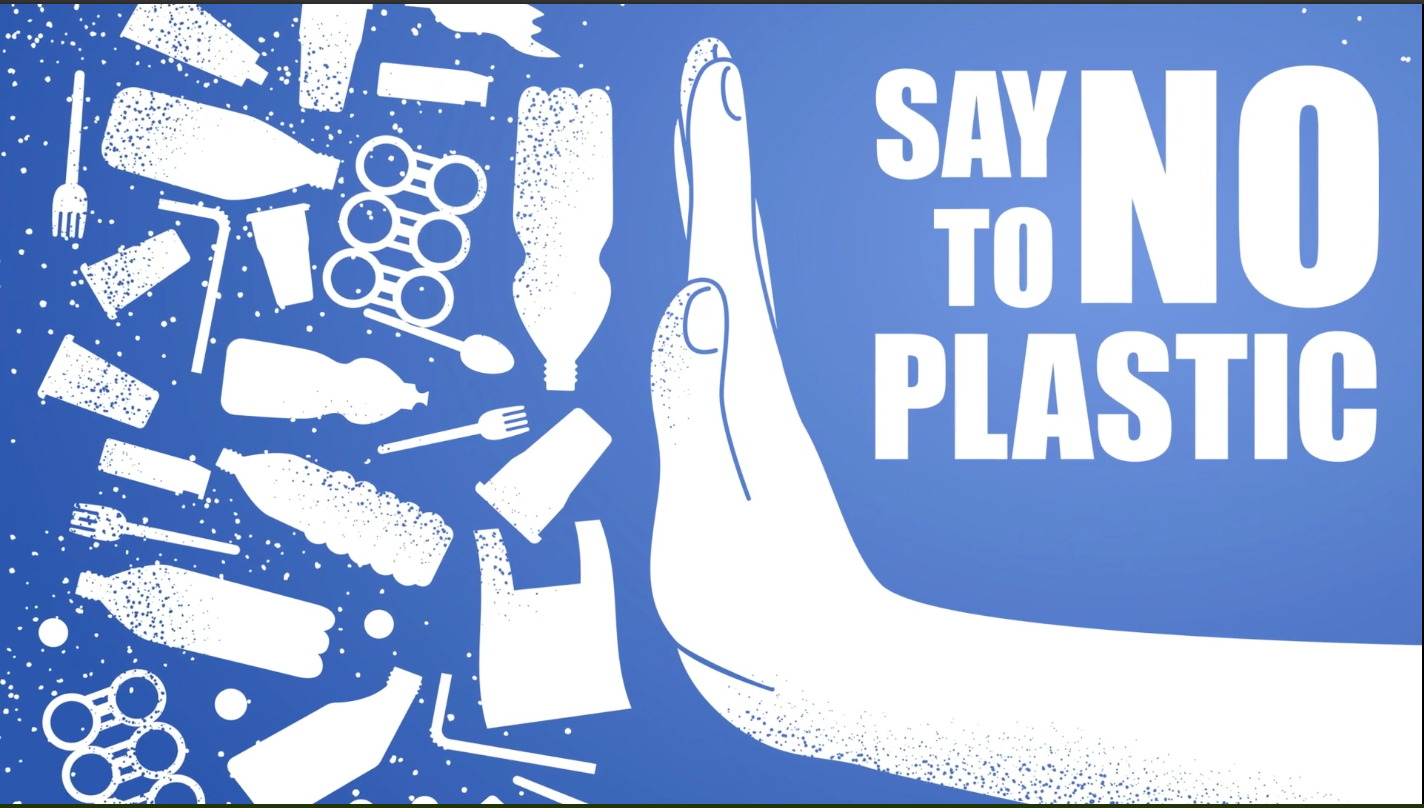
ข้อควรคำนึงถึงการออกแบบสไลด์ 3 ประการ โดยจะเน้นภาษาที่ใช้ในการนำเสนอบนสไลด์
1) Relevant and high-quality photos หารูปภาพที่เกี่ยวข้องมาประกอบ และรูปควรจะมีความละเอียดเยอะ เพื่อไม่ให้ภาพแตกในตอนนำเสนอ
2) Easy-to-read fonts เราจะต้องพิจารณาถึง font size และ font type โดยจะต้องอ่านง่าย สไลด์การนำเสนอของเราจะเป็น visual aids
3) One key message per slide มีเพียง 1 ประเด็นต่อ 1 slide เท่านั้น หารูปภาพปังๆพร้อม keyword ไม่กี่คำ
- Conference Style มีข้อมูลต่างๆบนสไลด์มากหน่อย เนื่องจากผู้พูดต้องการ inform ข้อมูลหรือชักจูงโดยการให้ข้อมูลเยอะๆ เช่นงานนำเสนอวิจัย
จะแสดงความสัมพันธ์ของข้อมูลตามที่เราพูด หรือคำเฉพาะมากๆจะหาภาพมาประกอบได้ยาก เช่น techincal field ต่างๆ สามารถใช้กฏ Rules of five or six ในการกำหนดให้แต่ละสไลด์มีไม่เกิน 5-6 ประเด็นเท่านั้น ตัวอย่างจากในรูปเลยจ้า
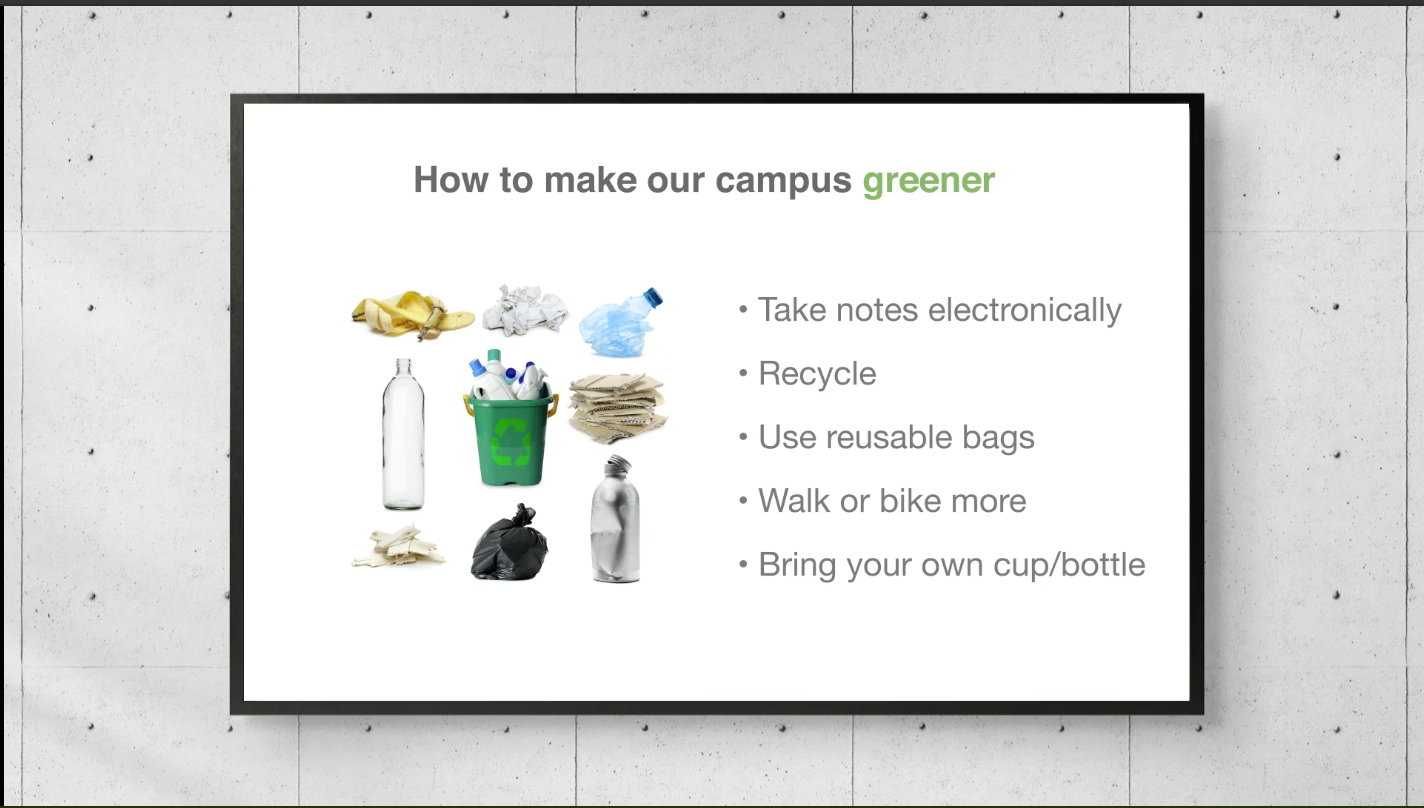
เราจะต้องใช้ set one pint at the time คือการใช้ animation เพื่อแสดงทีละประเด็นออกมาให้คนฟังได้อ่าน เพื่อไม่ให้เขาอ่านหัวข้อที่เรายังไม่ได้พูดไปก่อนล่วงหน้า
2) consistency of the language use
ภาษาที่ใช้บนสไลด์ ถ้าเป็น Ballroom Style เราจะใช้ keyword ไม่กี่คำ ประโยคสั้นๆ ทำให้เราไม่ต้องกังวลมากนัก แต่ถ้าเรามีมากกว่า 1 key message per slide จะต้องดู consistency of the language use ก็คือ ความสมํ่าเสมอ ความไปด้วยกันของภาษาบน slide เช่น ในตัวอย่าง ทุกประโยคขึ้นต้นด้วย Verb
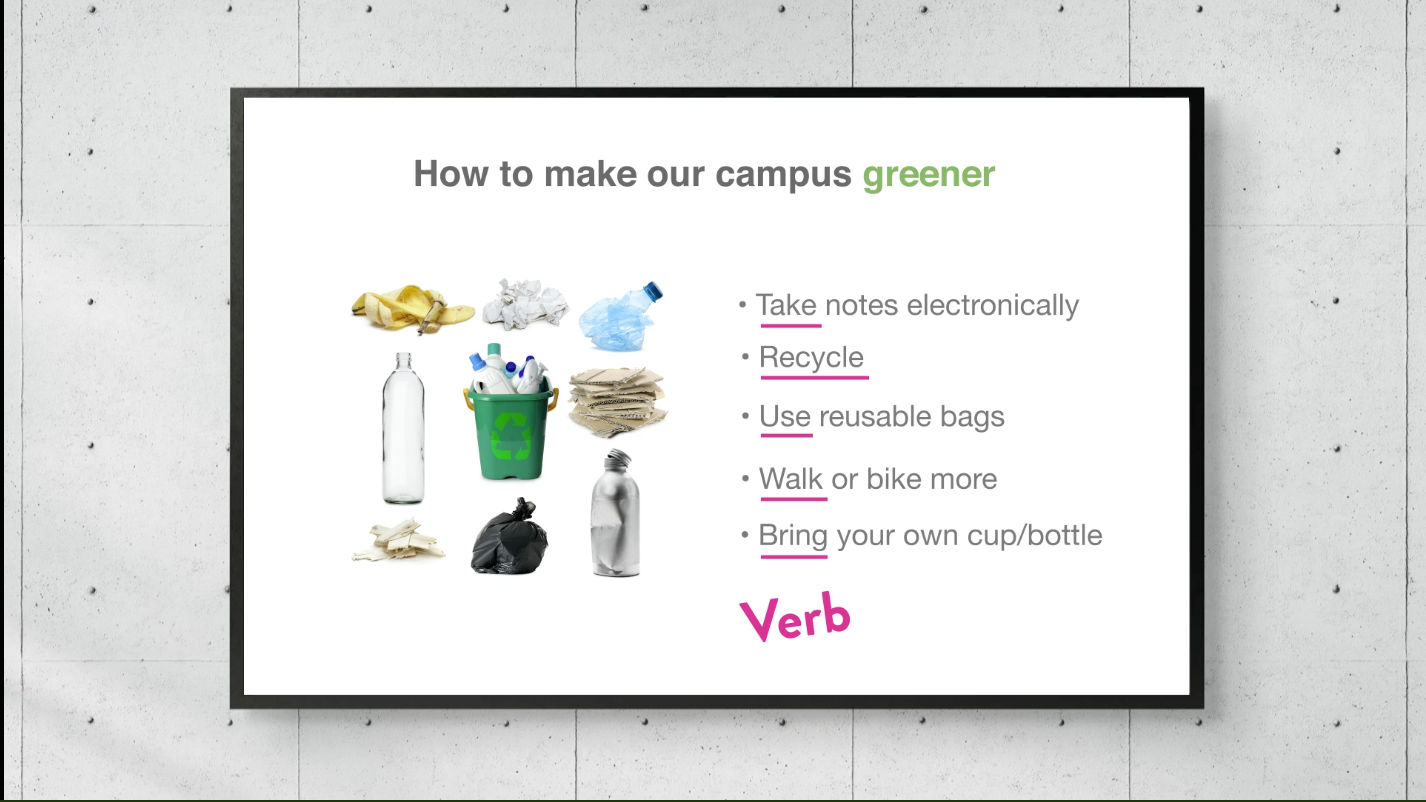
หรือตัวอย่างนี้โครงสร้างจะไม่เหมือนกัน ซึ่งเป็นตัวอย่างที่ผิดจ้า
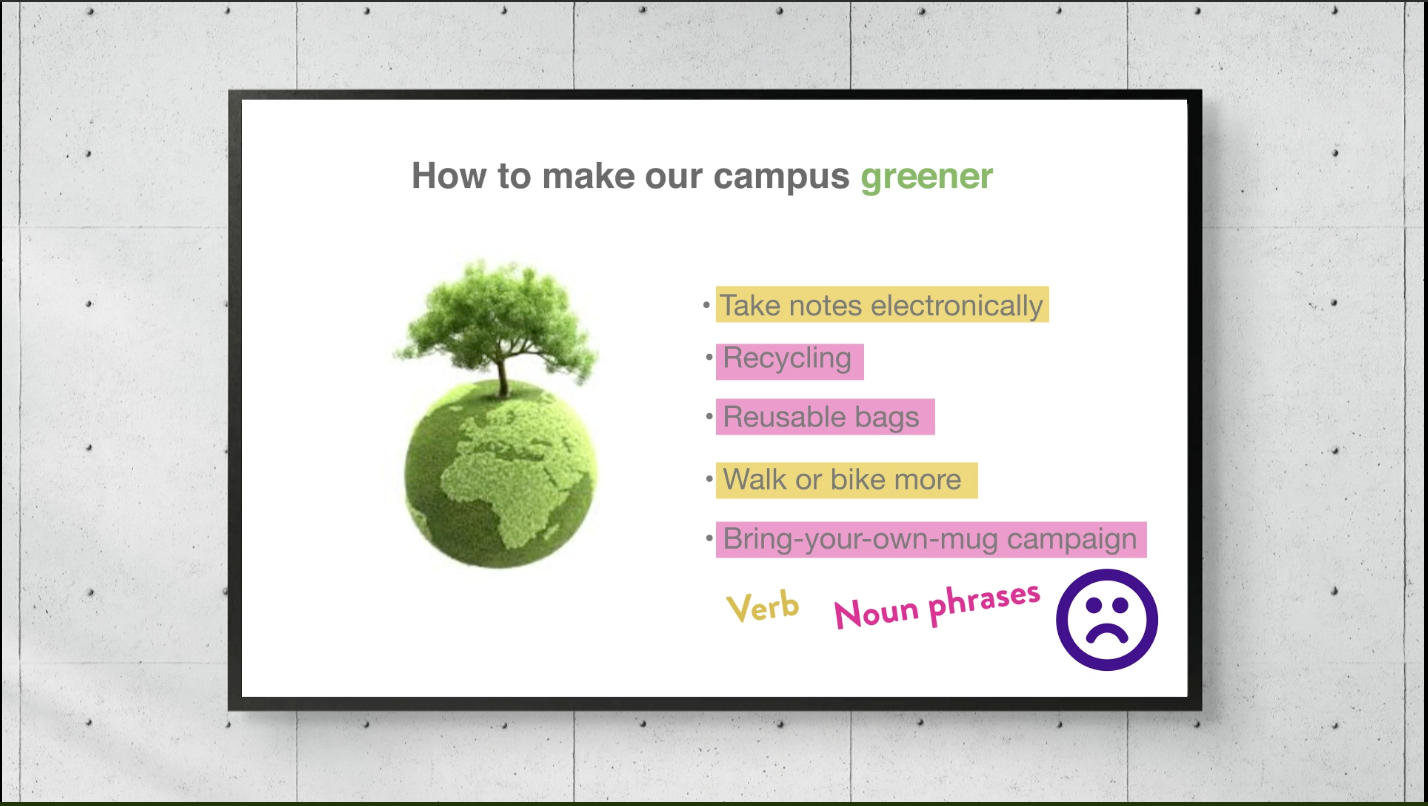
Ep 8: Visual message – Language for graphs and charts
นำเสนอตัวเลขต่างๆด้วย graphs หรือ charts จะทำให้คนฟังเห็นความสัมพันธ์ของตัวเลขได้มากขึ้น
ในบทเรียนนี้จะแบ่งเป็น 2 เรื่องด้วยกัน คือ
Which graph to choose? ควรเลือกใช้กราฟอะไรดี
ไม่ควรนำ Infographics มาใช้ในการนำเสนองาน โดยการแปะไว้บนสไลด์ เพราะว่า Infographic นั้นเป็นการสรุปเนื้อหาทุกอย่างมาอยู่ใน poster เดียวกันเนาะ ซึ่งจะไม่เหมาะกับการอธิบายแบบปากเปล่า
ถ้าสนใจเรื่อง Infographics สามารถอ่านเพิ่มเติมได้ที่นี่
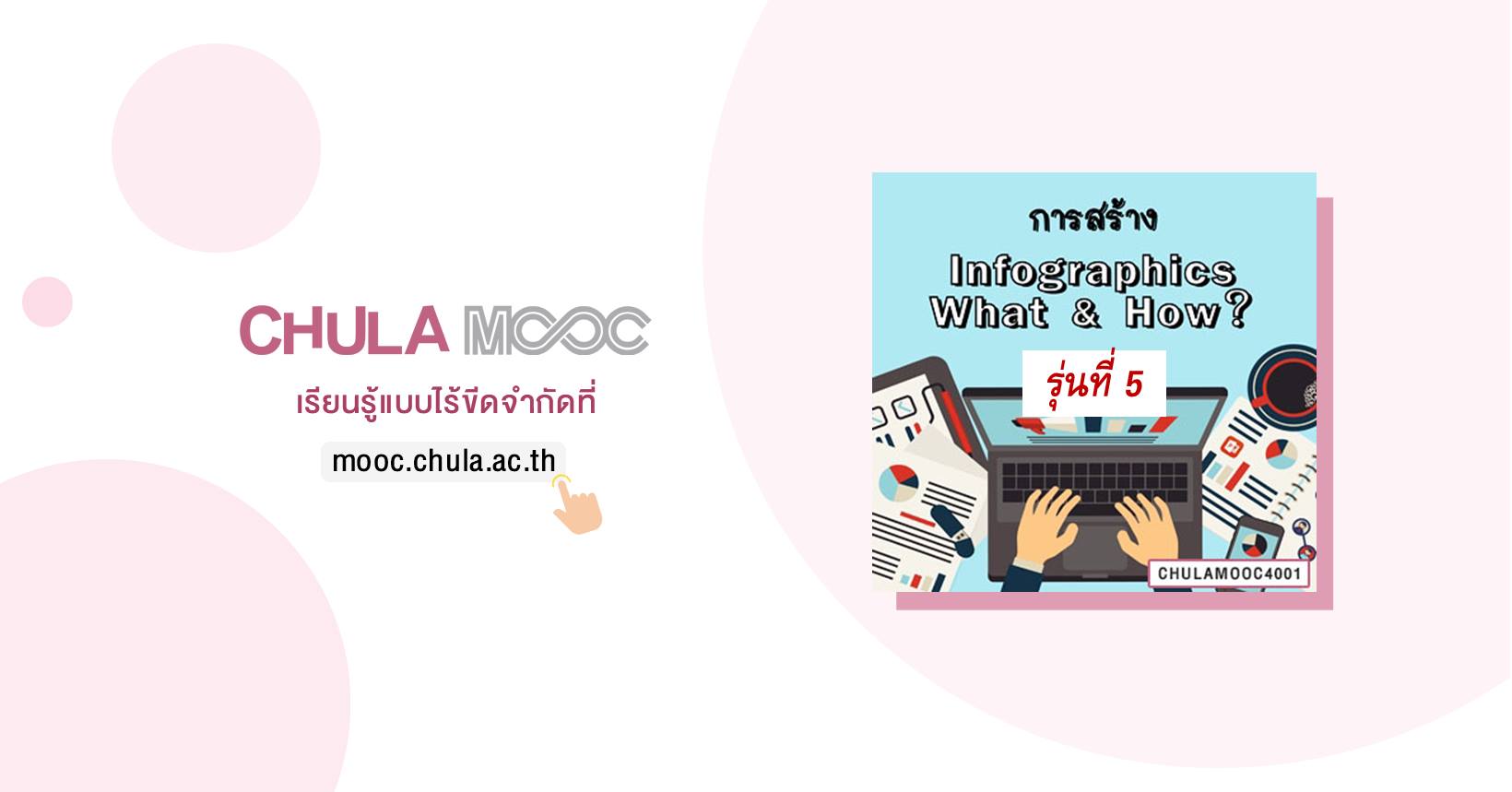
ดังนั้น เราควรเลือกจากวัตถุประสงค์ และข้อมูลที่เรามี เช่น
- bar graph (กราฟแท่ง) เอาไว้เปรียบเทียบข้อมูล
- pie chart หรือ circle graph (กราฟวงกลม) เน้นเป็นสัดส่วน หรือเป็นเปอร์เซ็นต์ของแต่ละส่วน รวมกันทั้งหมดจะได้ 100%
- line graph (กราฟเส้น) แสดงการเปลี่ยนแปลงในช่วงเวลาหนึ่งๆ
ควรนำข้อมูลตัวเลขที่เป็นตาราง แปลงเป็นกราฟประเภทต่างๆ
และสามารถนำเสนอข้อมูลพวกนี้ด้วยกราฟประเภทอื่นๆ ได้ตามความเหมาะสม เช่น
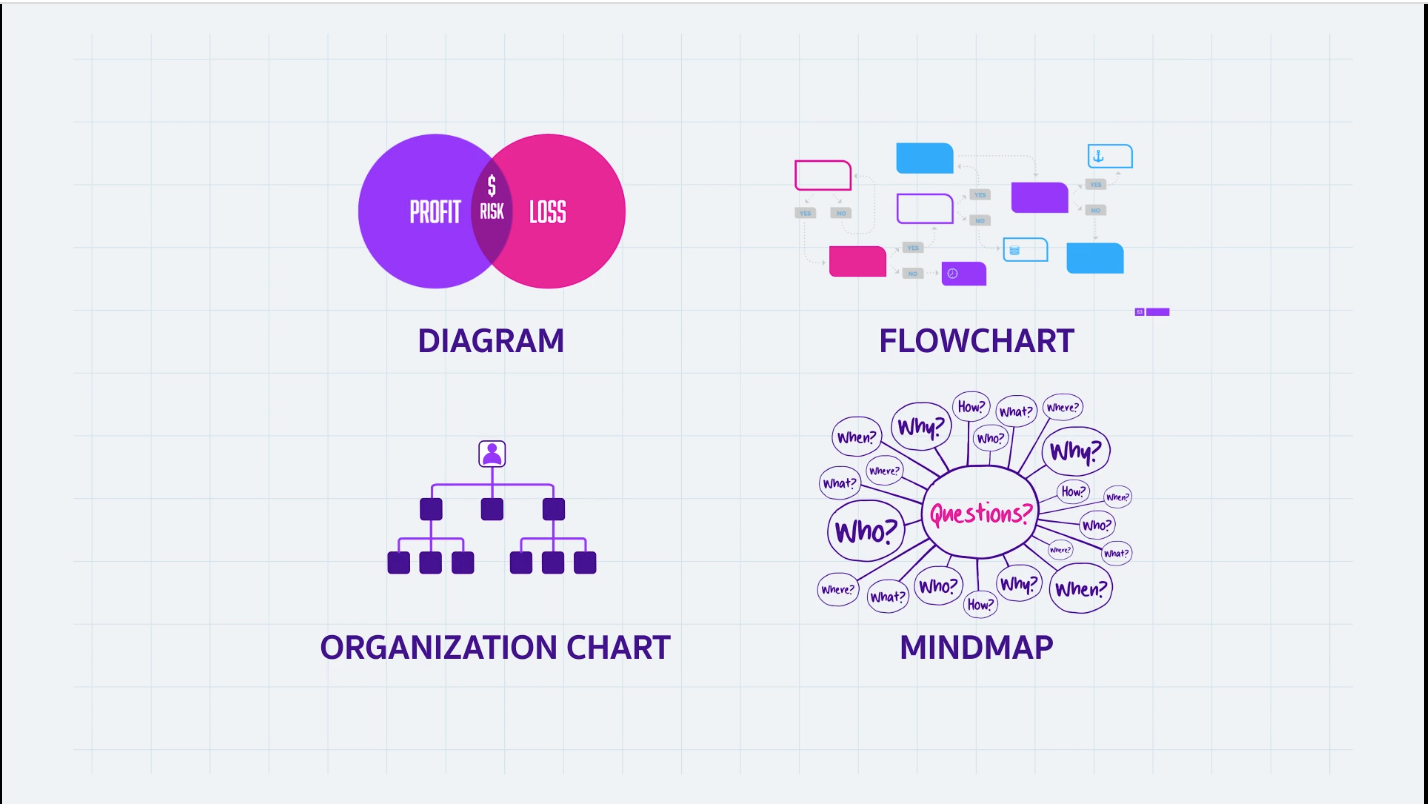
- diagram แสดงรายละเอียด ส่วนประกอบต่างๆ
- flowchart อธิบายการทำงานเป็นขั้นเป็นตอน
- organization chart แผนผังองค์กร
- mindmap ผังความคิด
Language for describing graph and charts ภาษาที่ใช้
มี 3 step ด้วยกันคือ
1) signposting to talking about graphs/charts
เกริ่นนำว่าเราจะพูดถึงกราฟนี้แล้วนะ
- I'd like you to look at this graphs/charts.
- Have a look at this.
- Let's have a look at this.
- Let's turn to this graph or chart.
2) introducing graphs/charts
บอกว่าเนื้อหาของกราฟนี้เกี่ยวกับอะไร
- The graph shows/represents/describes/compares + (what/where)
- The different colors indicate/represent ...
- It's divided into ... parts.
- I've broken it down into ... parts.
ตัวอย่างประโยคจ้า
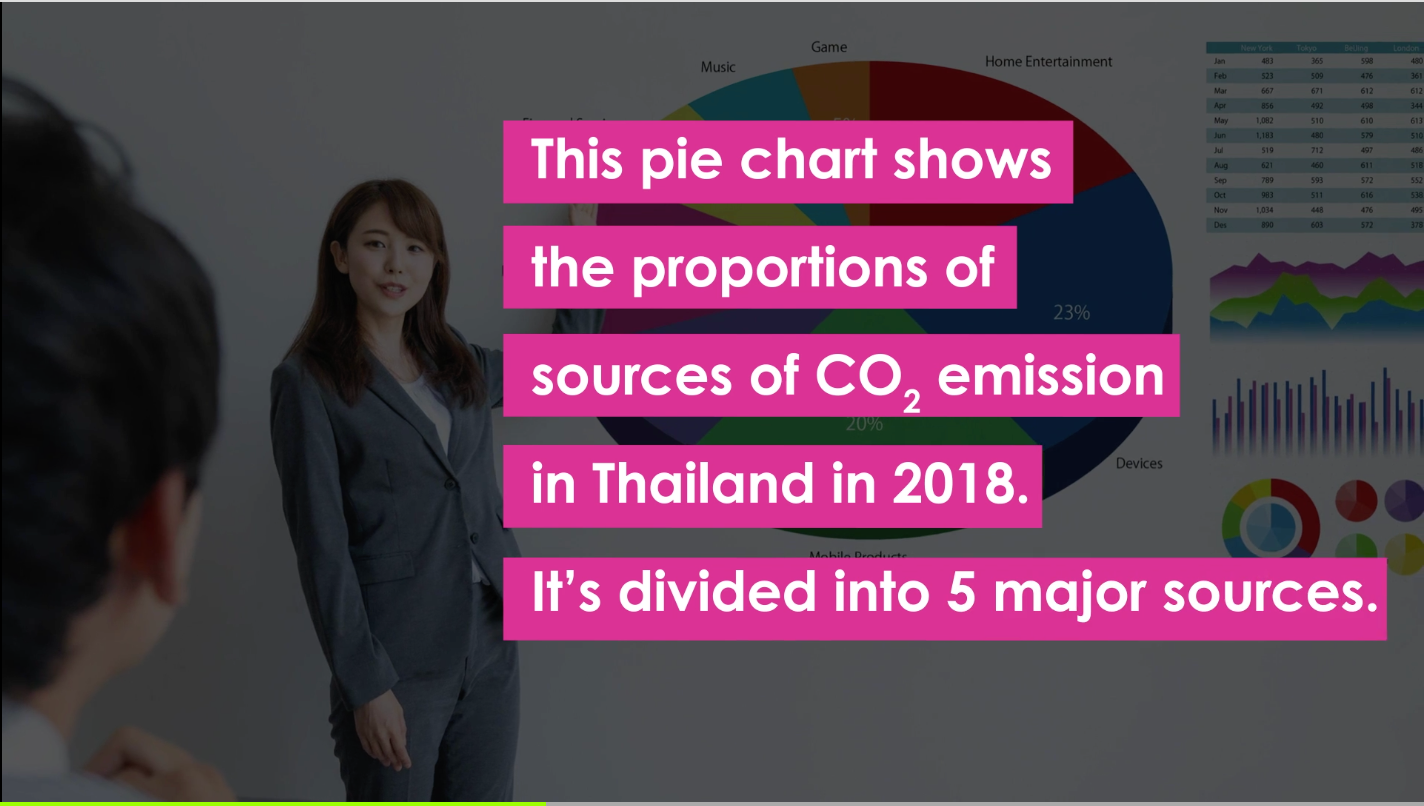
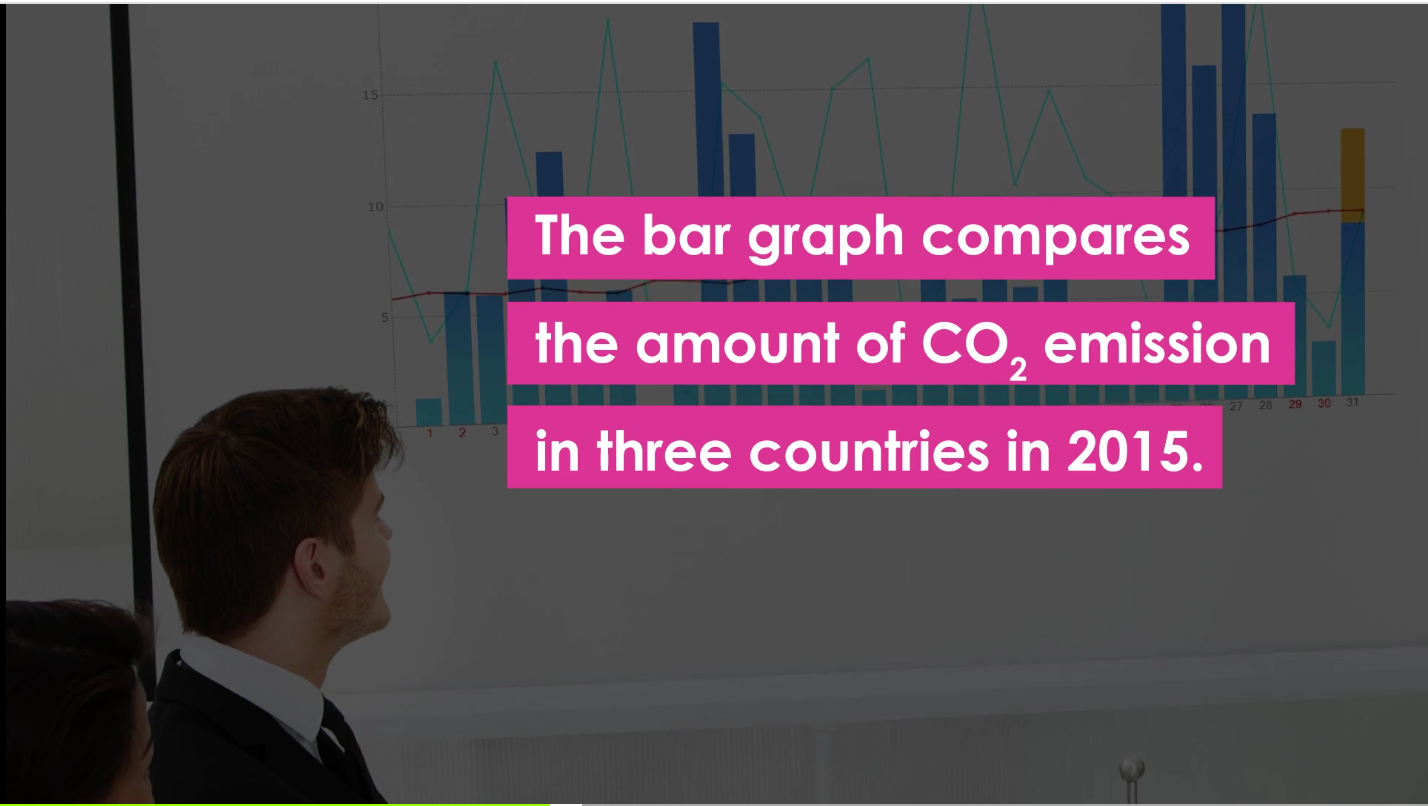
3) explaining key messages from graphs/charts
key messages คือเลือกประเด็นที่น่าสนใจ และเกี่ยวข้องกับที่เรากำลังพูดถึง เช่น พูดตอนที่เรากำลังจะชี้กราฟตรงนั้น
- Here we can see that ... {something happens here}
- As you can see from the graph, ...
- I would like ti draw your attention to this line.
เวลาที่เราอธิบายเนื้อหา หรือประเด็นหลักๆนั้น มีตัวอย่าง 2 แบบ ก็คือ
1) Talking about trends and figures การอธิบายตัวเลขหรือแนวโน้ม บน graphs หรือ charts นั่นเอง
Trends
ตัวอย่าง
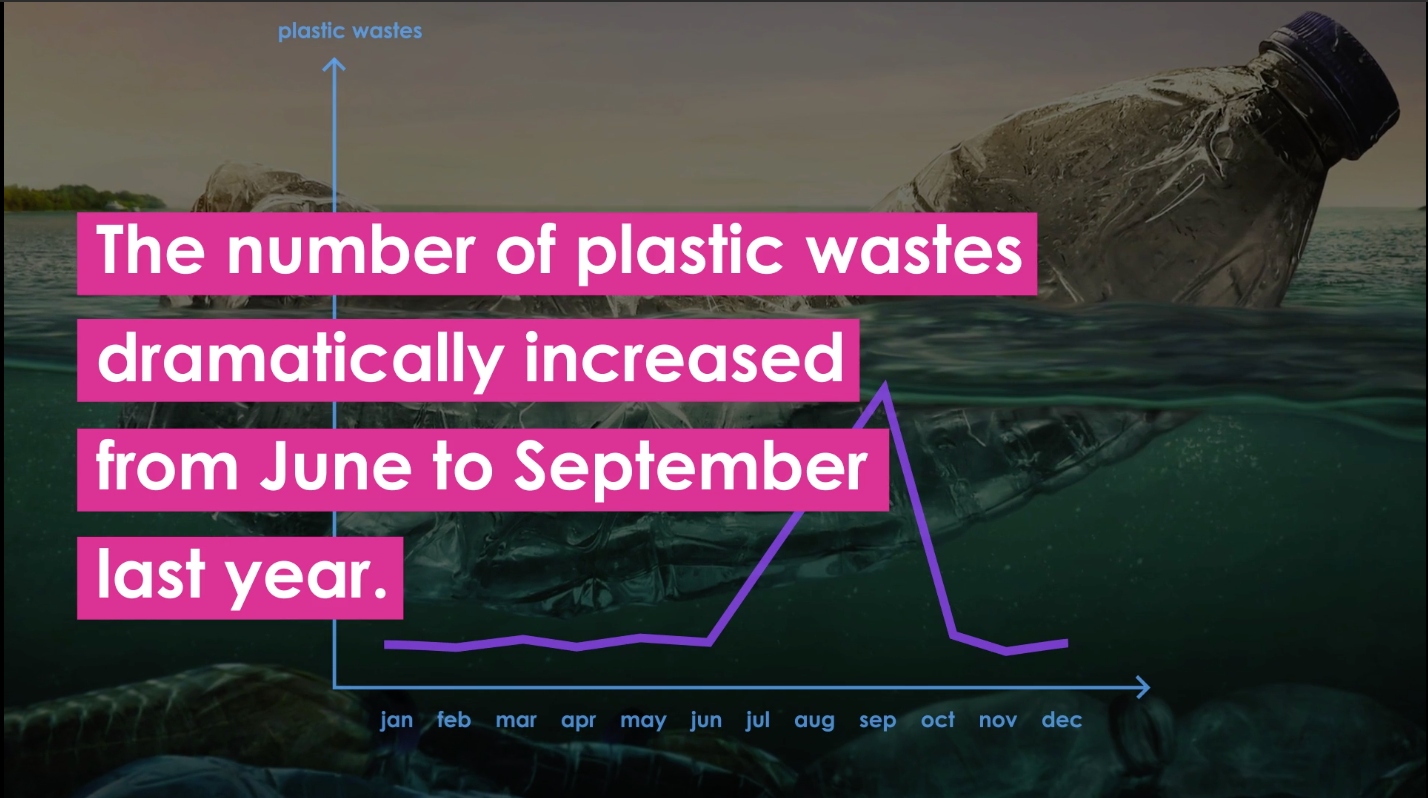
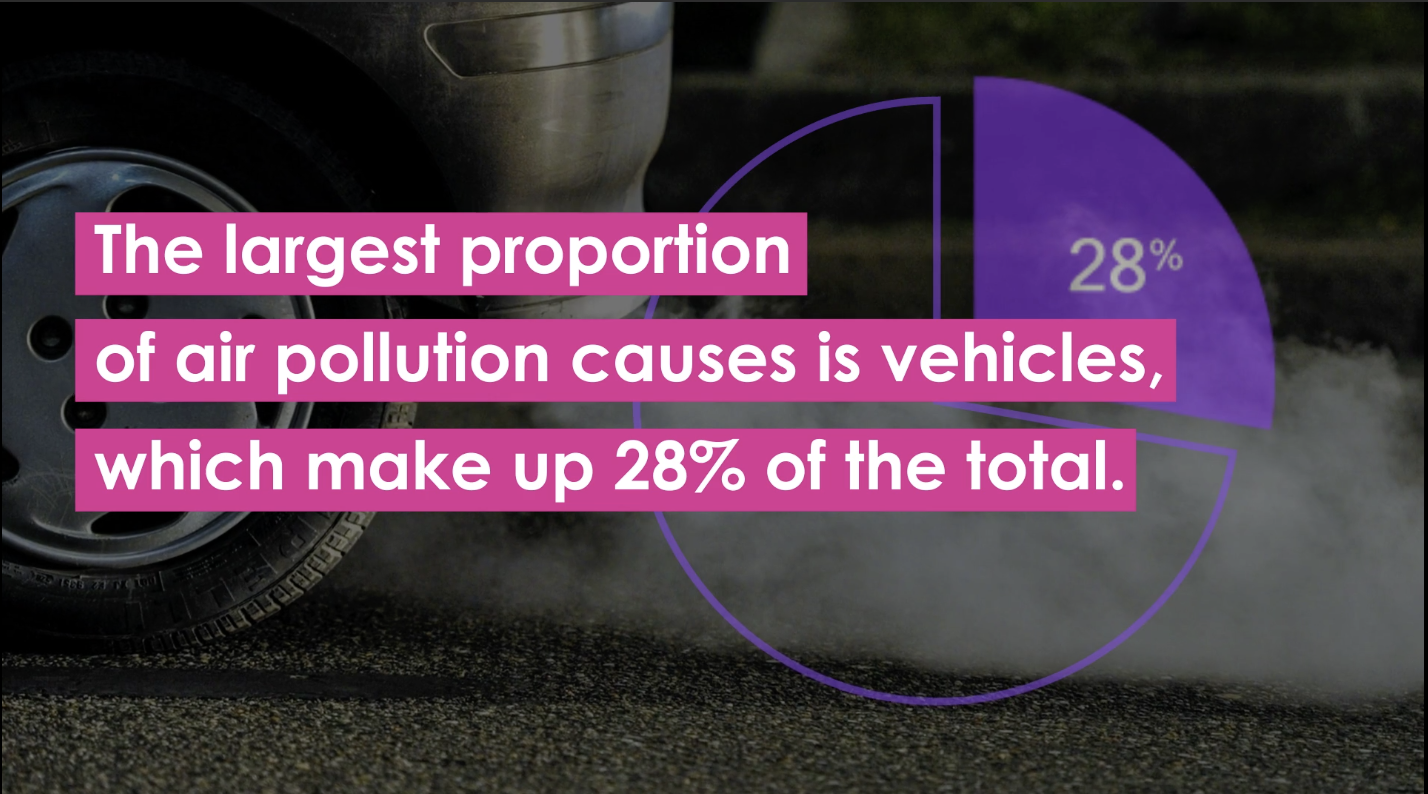
ตัวอย่างคำศัพท์ในการบอกเทรน จะมี
- มากขึ้น : increase, go up, rise
- เท่าเดิม : remain stable, stay the same, hold steadily
- ผันผวน : fluctuate
- ลดลง : decrease, go down, fall, decline, drop
adv ที่บอกความเร็วความแรง จะมี
- เพิ่มขึ้นอย่างรวดเร็ว : sharply, rapidly
- เพิ่มขึ้นอย่างมาก : exponentially, significantly, dramatically, considerably
- เพิ่มขึ้นไม่มาก หรือค่อยๆขึ้นไปอย่างสมํ่าเสมอ: gradually, steadily, continuously
- อย่างช้า : slightly, slowly
Tense ที่ใช้
- Present Simple Tense ใช้เพื่อบอกข้อเท็จจริงเนอะ เช่น The largest proportion of CO2 emission is fossil fuels. หรือใช้เพื่อ predict เหตุการณ์ หรือคาดการณ์ในอนาคต เช่น The number of plastic wastes is likely to go up next year.
- Past Simple Tense ใช้เพื่อพูดถึงเหตุการณ์ในอดีตที่ผ่านไปแล้ว เช่น The number of plastic wasted dramatically increased from June to September last year.
- Present Perfect Tense พูดถึงเรื่องที่กำลังเกิดขึ้นอยู่อย่างต่อเนื่อง เช่น The number of plastic wastes has slightly decreased over the last three months.
Figures คิดเป็น .. %
- make up ...% of the total
- account for ...% of the total
- contribute ...% to the total
ตัวอย่าง The largest proportion of air pollution causes is vehicles, which make up 28% of the total.
2) Describing causes and consequence การบอกเหตุและสิ่งที่ตามมา ตัวอย่างประโยค
- The energy consumption fell from 35 to 25 terawatts in the first quarter last year because of the fall in demand for heating.
- The cold weather was caused by a change in weather patterns, possibly the result of global warming.
กลุ่มคำเพื่อบอกเหตุและเล่าถึงผลที่ตามมา จะมี result in, due to, because of, cause, caused by, consequently, so, because
ตัวอย่างประโยค
I'd like you to take a look at this line graph. It compares the amount of plastic waste in the past three years. As you can see from the graph, the amount of plastic waste has declined significantly because people are more concerned about the environment. Consequently, the plastics industry was able to report a reduction in its carbon footprint earlier this year.
Ep 9: Conclusion
การฝึกซ้อม ช่วยทำให้การนำเสนองานเป็นภาษาอังกฤษให้ได้ดี และมีประสิทธิภาพยิ่งขึ้น
แหล่งข้อมูลในการเรียนรู้ ที่แรกหนีไม่พ้น TED Talk เราจะได้ฟังเนื้อหาที่หลากหลาย ได้ตัวอย่างการพูด ฝึกทักษะการพูดภาษาอังกฤษ และได้เรียนรู้คำศัพท์ใหม่ๆจาก transcripts
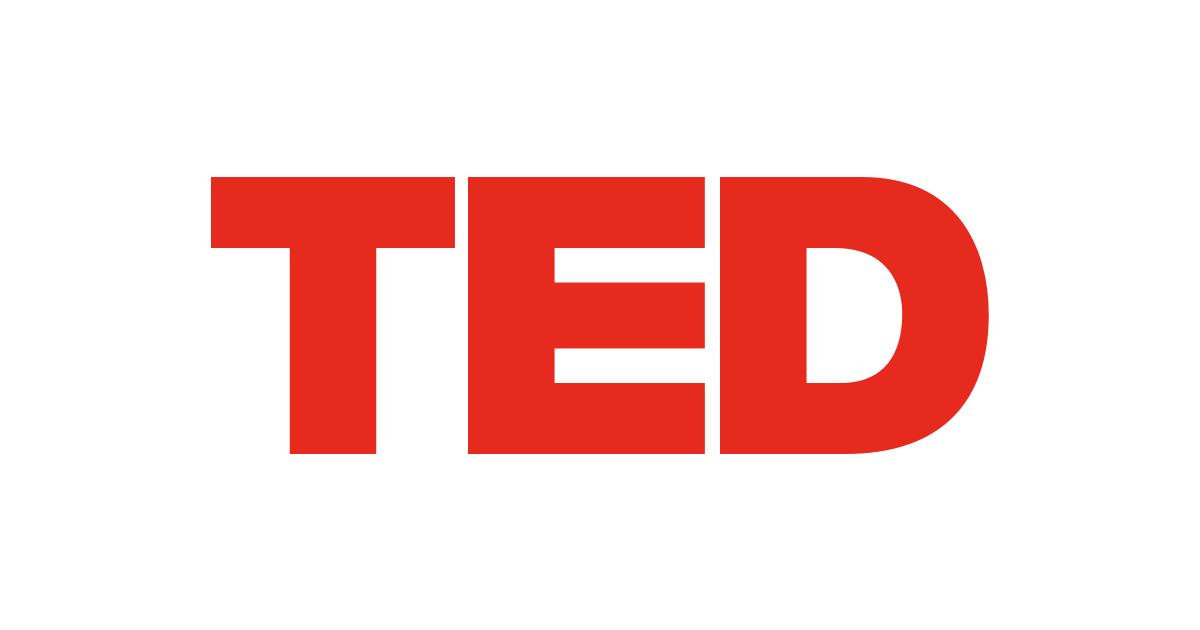
หรือของสถาบันภาษา จุฬาลงกรณ์มหาวิทยาลัย จะมีรายการที่ชื่อว่า "PRESENTATION TIPS @ HOME WITH AJ.P'JOY" เกี่ยวกับการนำเสนอผลงานจ้า

ทางเราก็หวังว่าการสรุปคอร์สเรียนนี้จะได้ประโยค เอ้ยย ประโยชน์กันไม่มากก็น้อยเนอะ
สุดท้ายฝากร้านกันสักนิด ฝากเพจด้วยนะจ๊ะ
อย่าลืมกด like กด share บทความกันด้วยนะคะ :)
Posted by MikkiPastel on Sunday, 10 December 2017
และฝากช่องทางใหม่ ทาง Twitter ฮับ
สวัสดีจ้า ฝากเนื้อฝากตัวกับชาวทวิตเตอร์ด้วยน้าา
— mikkipastel (@mikkipastel) August 24, 2020





